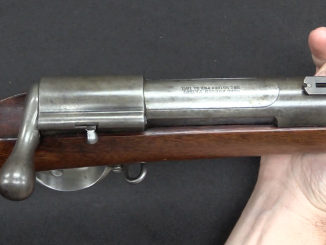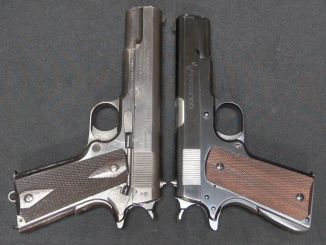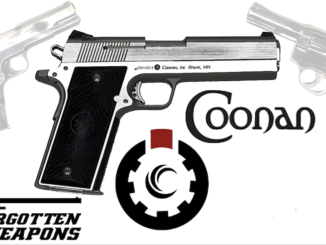Hyman Lehman was a gunsmith in Texas who made a variant of firearms for some of the most notorious gangsters of the 1930s. One of his specialties was to take the Winchester Model 1907 Self-Loader and cut the barrel down, attach a Cutt’s Compensator, and a Thompson gun vertical front grip on a replacement metal handguard. Dillinger’s friend and compatriot Homer Van Meter was particularly fond of this sort of rifle.
When Dillinger was arrested in Tucson in January 1934, two of these rifles were among the guns taken from him. One was one display at the Tucson PD headquarters for many years, although it appears to have been taken down not long ago.
Incidentally, I would love to get a look at one or both of those examples – especially to see if they are actually converted to fully automatic. I was unable to get any response form inquires to the Tucson Police while filming this video, but if anyone from the department happens to see this video and can arrange something, please reach out to me at admin@!forgottenweapons.com ! A followup video on an original example would be excellent.
Anyway, a shop called Bull Creek Arms in Idaho produced a short run of 20 reproduction Lebman-style 1907s about 15 years ago and that is what we are looking at today. For more information on the original Winchester 1907SL, including its use in World War One, I suggest the C&Rsenal video on the subject:




“(…)Cutts Compensator(…)tested by the US Army at Springfield
on the Springfield 1903(…)Lebman found them, bought the compensators and mounted them on these 1907(…)”
Wait. Springfield 1903 is using 7,62×63 cartridge, whilst Model 1907 is using 8,9x35SR cartridge. Latter use bullet with bigger diameter, so how it could be used with muzzle device expecting smaller diameter?
“(…)push that back and it cycles the bolt back(…)”
Untypical way of cocking was repeated in Russian PP-90M1 https://modernfirearms.net/en/submachine-guns/russia-submachine-guns/pp-90m1-eng/
“(…)we presume that Lebman either used machined aluminium(…)”
That is material which does like to transfer heat. Thermal conductivity from
https://www.engineersedge.com/properties_of_metals.htm
– aluminum 136
– steel mild 26.0…37.5
Which raise question if it would not became dangerously hot after using full-auto, especially considering that original barrel certainly was NOT designed for such mode of fire.
If yer a gangster, better a ‘dangerous ly hot’ barrel than getting dangerous ly shot by the G- men, see? It’s like a turbocharger on a getaway car. You risk yer gear to save yer life an’ yer lot.
That thing has nowhere enough mag capacity to make it an issue.
“(…)arrested in Tucson in January 1934(…)”
The Arizona Daily Star https://tucson.com/jan-26-1934-john-dillinger-captured-in-tucson/article_db900262-3c8e-11ea-8a50-bf1a214893b9.html claims that
(…)In the North Second avenue address were found two Thompson sub-machine guns, one, of the regulation, 45 calibre and one of the new “tank gun” models, chambered for the superior powerful 351 calibre rifle bullet.
In addition there were two of the latest type steel and velvet bullet-proof vests and many hundred rounds of ammunition. Two handguns were also taken(…)
Which lead me to wonder if it was actual Thompson chambered in .351 (only prototypes were made, so far I know) or it is 1930s U.S. press language for denoting Winchster Model 1907 with attached Thompson front grip?
No. The guns they seized have all been documented. There were three Model 1921AC Thompsons, one Model 1928AC Thompson, two of the mentioned Winchester conversions (the so-called “tank guns”), a bunch of lever-action rifles, and a number of handguns.
It is normally safe to expect that reporters know very little to nothing about firearms. Clearly, this was as true in the 1930s as it is now.
“(…)The first was the Model 1905, the second
was the 1907, the third was the 1910.(…)”
It is so, if you only count central-fire one. Model 1905 was itself developed from Model 1903 https://www.historicalfirearms.info/post/181311063062/winchesters-self-loading-rifles-in-the-early which used .22 rim-fire cartridge, which is NOT .22 Long Rifle. It must be quite popular as it was modernized in 1933 into Model 63, which used .22 Long Rifle and Model 63 production ended in late 1950s.
My department auctioned off our last five 1907s and about 20 M1 carbines back in 2005 for $150 apiece. We kept the Thompsons. The Motor Bandit era yielded some awesome gun sales on both sides of the law.
I wrote a long and extensively sourced article in ARMAX about these things, called “American ‘Gangster Gats’: Illicit Automatic Conversions of the Winchester Model 07 Self-loading Rifle in the 1930s” (ARMAX Vol. VIII No. 2) (https://www.armaxjournal.org/doi/armax41181), in which I explain the history and details about these conversions. For starters, it is unlikely that Hyman Lebman had anything to do with them (detailed explanation in the article). I also discuss many of the internet myths you mention here.
– It is pretty certain that all of the four known conversions (not just the two seized in Tucson) were full-automatic. Again, I explain why in the article.
– The first reason you give why they should not be full-automatic is actually invalid because these were no used with the 10-rounders you depict, but with artisan-made 20-round magazines. I discuss these at length in the article, complete with photos from the 1930s AND from an existing sample now in the hands of an advanced collector.
– I am fairly certain that the handguards were made of aluminium, because that was the material used by holster-makers of the day to produce the moulds for the leather. Many gunsmiths who were also holstermakers, like Lebman incidently, were thus proficient in working with aluminium.
– Lebman was convicted under the 1933 Texas Act “Making It an Offense to Possess or Use Machine Guns”, which outlawed making a machine gun. However, that was in connection with an Auto-Ordnance Model 1927AC Thompson that was found converted in his store in 1934.
– Homer van Meter very likely has never fired one of these conversions. The two in Tucson were seized before van Meter joined the Dillinger-Nelson Gang (at least as far as we know). The weapon seized on 31 March 1934 from his car was an ordinary Winchester Model 07, as was the one he used on 30 June 1934 to murder Patrolman Howard Wagner in South Bend.
Hans:
I am sure you are right. There seems no point going to the trouble of fitting a new fore end and pistol grip, and Cutts compensator, if the carbine is not to be made fully automatic. It functions just fine as a semi-automatic without these expensive modifications.
A dissent: The 1910 Winchester is anything but “a brutal rifle to shoot”. Mine is very easy on the shoulder and shoots well within 100 – 150 yards. What is brutal is using the very small operating rod to charge the weapon, and loading the 4-shot magazines.
I’ve never seen one of these torn down before, and the thing that strikes me as being fairly significant is this: I now realize that these guns are perhaps the first example out there of the same “mass forward” blowback design that eventually led to things like the Uzi and Ingram SMG designs.
You also really have to wonder why more designers of the era weren’t looking at this and going “Yeah… I could use that in an SMG…”
I’ve handled one of these, back when I was a know-nothing of a kid, and it never dawned on me that they were blowback designs, rather than some form of locked breech. Of course, I didn’t ever get a chance to fire one, sooooo… Yeah. The facts just didn’t connect.
If you’re laying out the design heritage of many modern SMG designs, you absolutely have to have these guns in there somewhere, even if the folks designing them didn’t recognize them for what they were.
The connection was actually fairly direct.
https://www.forgottenweapons.com/light-rifle-program/woodhull-carbine/
After that came the Woodhull submachine gun.
http://firearms.96.lt/pages/Rare%20US%20submachine%20guns%20WW2.html
Most sources state that the Woodhull SMG came first, but in fact it was submitted in February 1942 in .45 ACP, after the .30 USC carbine version had been rejected. In the end, the GM Inland Division T20, designed by George Hyde & Co., was chosen, becoming the M3 “Grease Gun”.
The first actual SMG to have the “overhung bolt” with the mass mostly up-front as a deliberate design feature was apparently the British MCEM 2 designed by Podsenkowsky at Enfield in 1945.
https://www.genitron.com/Unique-Handgun/18/Podsenkowsky-MCEM-2-Pistol
More of a true “machine pistol” intended for paratroops, it was rejected on the grounds that its 18-round magazine seemed incompatible with its roughly 1,000 R/M rate of fire.
cheers
eon
The connection was even closer. At least by 1933, some gunsmith, possibly the same who did the carbine conversions, produced at least half a dozen 9x19mm submachine guns based on the Model 07. I discuss these also in my article “American ‘Gangster Gats’: Illicit Automatic Conversions of the Winchester Model 07 Self-loading Rifle in the 1930s” (ARMAX Vol. VIII No. 2) (https://www.armaxjournal.org/doi/armax41181). These were very involved conversions that featured a sound suppressor, raised sights to clear the suppressor, and modified magazines based on the Luger T.M.08 drums.
“(…)first actual SMG to have the “overhung bolt” with the mass mostly up-front as a deliberate design feature was apparently(…)MCEM 2 designed(…)1945.”
I predate this with Pistolet Mitrailleur Modèle 1939 https://guns.fandom.com/wiki/Petter_Mle_1939 which used a blowback-operated action utilizing an L-shaped bolt, in which much of the bolt’s mass lay in a long tubular section over the barrel. which was designed in 1936.
Problem is in the mind, 100 years ago apparently they could not bridge mentally the gap between a pistol and a rifle, so you (first) got a smg that was rifleish in dimensions, weight and handling. All the tehnology was there.
I wonder are there examples now (on any other subject) where we do something not seeing so easy and more efficent other way – most of the guns now regressed to simplicity compared to clockworkish end of 19th century.
@Storm, who said:
“I wonder are there examples now (on any other subject) where we do something not seeing so easy and more efficent other way – most of the guns now regressed to simplicity compared to clockworkish end of 19th century.”
I often wonder about this same question, because there are times when I look at issues and something about that issue just bothers me, something lurking in the back of my mind about how I’m looking at it. As if my subconscious is telling me I’m missing something very obvious…
There’s a good deal to think about, with these sorts of things lurking at the edges of our consciousness. Like, can anyone explain to me why humans would have evolved the “uncanny valley” reaction to things presenting as “not quite human”, unless there was a reason in the environment? One we don’t have, today?
Likewise, why the hell do tigers have those little “false eye” patches on the backs of their ears? What the hell predates on tigers, that they’d evolve such a thing?
You look at a lot of things, and you’re left thinking that there is a lot of “very obvious” lurking out there, in the underbrush, ready to ambush your ass the way it used to ambush tigers.
There’s also a lot of “lock-in” going on with thinking about things. Look at the whole “drone” problem: All of us look at that, and because we’ve “seen” guns and so forth taking down birds for literal centuries, that’s the line down which all our minds run. Gotta be a gun, or something, to solve that problem…
What it amounts to is “I gotta hammer; all my problems are nails…” Meanwhile, there are other ways of doing things, like a compressor and a nail gun. Also, hammering that screw into the wall isn’t an optimal use of either screw or hammer…
I think a lot of problems can be reduced to the bare basics, and then solved creatively by throwing out all your preconceived notions of “how to do it”. The trouble is that attaining that zen-like state of first exposure to something is damned hard to do…
Its an opening of very broad discussion and subject, but evolution wise (now thats mentioned), something is happening fairly rapidly to a human race in 21st century, it seems like there is a decade at least of youth shift.
30, 40 years ago, people in their fifties looked and were precieved as old, in 60s were hardcore grannies and grandads with white hair and walking stick.
Now, many people in 50s are like slightly middle aged, looking close to yesteryear 40s. Internet is full of examples of such photos.
Hell, Ian is the best example – he almost looks the same as 10 years ago! Like some freaking Dorian Gray of firearms, heh.
I’m mention all of this in attempt to correlate if this drastic youth switch can happen, maybe some other changes (also) in human behaviour and thought wait around the corner – of course, with caveat that possibly some of it not good ones.
If you cross-correlate with “life experience”, all too many of those “young-looking” sorts are drastically inexperienced, in some senses.
Case in point: By the time most of the so-called “greatest generation” was in their fifties, they’d been through a depression of excessive magnitude, the biggest war in history, an era of comparative prosperity and several other wars plus the stress of the Cold War living in the background continuously. All that crap takes a toll…
By comparison? LOL… The vast majority of my generation lived in a low-stress paradise, despite their constant whinging about it all. Same with all the younger cohorts. For any of them, war was an optional thing, and deprivation? Non-existent, in any real sense. No wonder they’re aging better.
Of course, on the flip side, they’ve all had to deal with crap that the older generation didn’t, like highly processed food in their diets, along with all the preservatives in said food. I suspect that whatever is going on has rather more to do with the environment than some genetic or epigenetic changes. The modern American or European has zero concept of what typical “stress” was for most of human history, and they sure as hell don’t know how good they’ve got it all. If they did, they’d be taking rather better care of it than they are. We all seem hell-bent on bringing back the hell-times, mostly through stupidity.
I mean, look at California. How the f*ck do you f*ck up California? That’s a damn natural paradise that needs very little in the way man-made intervention to keep it a paradise, and what have they done with it all? LOL… The idjit class down there that they put in charge of everything has created the conditions that they now have to endure, and everyone is re-enacting Kipling’s “The Gods of the Copybook Headings” and demanding to know why all this terrible stuff is happening to them…
It’d be funny, if it weren’t simultaneously so tragic. You elect idjits who’re more worried about imaginary gender and racial grievances than they are with keeping the fire department manned and the forests in a state of non-tinderboxedness? Guess what results? Just turn on the news, to see.
I see a far more direct lineage, one that incorporated the full package all along.
That oh-so-innovative “telescoped bolt” that was just too complex and expensive to think up or afford for SMGs until the fifties is the exact same thing as the slide that cheapo “Saturday night special” pistols had been using since at least 1910 – and OBTW, they also used the “clever and innovative” mag in grip layout.
The most ironic part is that it’s so much easier to have a trigger pull down a slide-stop-like sear right above it than to engineer a reacharound transfer bar and a tiny FCG that has to fit above your thumb web.
If you are wondering what would be result of someone trying to create sub-machine gun without knowing how one is built internally but having access to automatic pistol from 1st half od 20th century then see https://www.forgottenweapons.com/submachine-guns/polish-beha-smg/
telescoped bolt = Browning slide
exactly
I had a 1907. The fore arm was badly cracked where it was thinnest but someone was making replacements back in the 1990’s so I put one on. The trigger was absolutely terrible. People complain about ‘lawyer triggers’ today; this was much worse. The recoil wasn’t the worst as far as the amount of punch but the recoil compounded with the weight jumping around made shooting it not something to enjoy. I don’t see how a full auto version would be a good experience. I was happy when I sold it.
Ours were well made and had some modern features, at least by trun of the century standards. They have a weird recoil impulse for such an underwhelming cartridge, though, and I’d imagine that’s one reason the Remington Model 8 eclipsed it. Cool, though, at a time when there weren’t many options.
Note that the “forward-weight” blowback system lives on in the current 9mm Henry Homesteader, improved with a fairly reasonable tool-free takedown system. The cocking rod or plunger on these Winchesters was designed because J.M. Browning still held the patent (from his A5 autoloading shotgun) on the cocking handle connected to the breechblock. I’m sure marketing this as a feature suitable to saddle-scabbard guns was an afterthought.